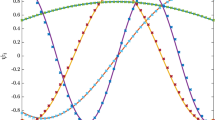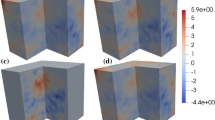Abstract
With the increase in computational facilities, interest in probabilistic analysis of engineering structures are observed to grow for a realistic assessment of physical systems. While the probabilistic analyses are generally carried out considering random variable models of physical parameters, a spatially varying random field model is more realistic. A discretization method converts the continuous parameter random field to a set of random variables. Truncated Karhunen–Loève (KL) expansion is one of the popular methods for the discretization of a random field. An accurate discretization can be achieved by considering a fine mesh along with a large number of terms. However, an increase in the number of elements and/or inclusion of more terms leads to an increase in computational cost. It is also found that only an increase in the number of terms in the expansion or number of elements alone does not provide an accurate representation of the random field. An adaptive discretization strategy is presented, which will suitably discretize the concerned domain while ensuring that both global and local level errors are kept within the prescribed limit.












Similar content being viewed by others
References
Ma X, Zabaras N (2011) A stochastic mixed finite element heterogeneous multiscale method for flow in porous media. J Comput Phys 230(12):4696–4722. ISSN 0021-9991. https://doi.org/10.1016/j.jcp.2011.03.001. http://www.sciencedirect.com/science/article/pii/S0021999111001318
Li J, Tian Y, Cassidy MJ (2015) Failure mechanism and bearing capacity of footings buried at various depths in spatially random soil. J Geotech Geoenviron Eng 141(2):04014099. https://doi.org/10.1061/(ASCE)GT.1943-5606.0001219
Shinozuka M (1972) Probabilistic modeling of concrete structures. ASCE J Eng Mech Div 98:1433–1451
Ditlevsen O (1988) Stochastic model of self-weight load. J Struct Eng 114(1):222–230. https://doi.org/10.1061/(ASCE)0733-9445(1988)114:1(222)
Heng L, Dongxiao Z (2013) Stochastic representation and dimension reduction for non-gaussian random fields: review and reflection. Stoch Environ Res Risk Assess 27(7):1621–1635. https://doi.org/10.1007/s00477-013-0700-7 (ISSN 1436-3259)
Ghanem R, Spanos P (1991) Stochastic finite element: a spectral approach. Spinger-Verlag, New York
Stefanou G (2009) The stochastic finite element method: past, present and future. Comput Methods Appl Mech Eng 198(9):1031–1051. ISSN 0045-7825. https://doi.org/10.1016/j.cma.2008.11.007. http://www.sciencedirect.com/science/article/pii/S0045782508004118
Allaix DL, Carbone VI (2009) Discretization of 2d random fields: a genetic algorithm approach. Eng Struct 31(5):1111–1119. ISSN 0141-0296. https://doi.org/10.1016/j.engstruct.2009.01.008. http://www.sciencedirect.com/science/article/pii/S014102960900011X
Vanmarcke E, Grigoriu M (1983) Stochastic finite element analysis of simple beams. J Eng Mech 109(5):1203–1214. https://doi.org/10.1061/(ASCE)0733-9399(1983)109:5(1203)
Liu WK, Belytschko T, Mani A (1986) Random field finite elements. Int J Numer Methods Eng 23:1831–1845. https://doi.org/10.1002/nme.1620231004
Kiureghian AD, Ke J-B (1988) The stochastic finite element method in structural reliability. Probab Eng Mech 3(2):83–91. ISSN 0266-8920. https://doi.org/10.1016/0266-8920(88)90019-7. http://www.sciencedirect.com/science/article/pii/0266892088900197
Deodatis G (1990) Bounds on response variability of stochastic finite element systems: effect of statistical dependence. Probab Eng Mech 5(2):88–98. ISSN 0266-8920. https://doi.org/10.1016/0266-8920(90)90012-9. http://www.sciencedirect.com/science/article/pii/0266892090900129
Takada T (1990) Weighted integral method in stochastic finite element analysis. Probab Eng Mech 5(3):146–156. ISSN 0266-8920. https://doi.org/10.1016/0266-8920(90)90006-6. http://www.sciencedirect.com/science/article/pii/0266892090900066
Loeve M (1977) Probability theory I. Springer-Verlag, New York
Zhang J, Ellingwood B (1994) Orthogonal series expansions of random fields in reliability analysis. J Eng Mech 120(12):2660–2677. https://doi.org/10.1061/(ASCE)0733-9399(1994)120:12(2660)
Li C, Der Kiureghian A (1993) Optimal discretization of random fields. J Eng Mech 119(6):1136–1154. https://doi.org/10.1061/(ASCE)0733-9399(1993)119:6(1136)
Brenner CE, Bucher C (1995) A contribution to the SFE-based reliability assessment of nonlinear structures under dynamic loading. Probab Eng Mech 10(4):265–273. ISSN 0266-8920. https://doi.org/10.1016/0266-8920(95)00021-6. http://www.sciencedirect.com/science/article/pii/0266892095000216
Wiener N (1938) The homogeneous chaos. Am J Math 60(4):897–936. ISSN 00029327, 10806377. http://www.jstor.org/stable/2371268
Ghanem R, Spanos PD (1990) Polynomial chaos in stochastic finite elements. J Appl Mech 57(1):197–202. https://doi.org/10.1115/1.2888303
Chen Y, Jakeman J, Gittelson C, Xiu D (2015) Local polynomial chaos expansion for linear differential equations with high dimensional random inputs. SIAM J Sci Comput 37(1):A79–A102. https://doi.org/10.1137/140970100
Pranesh S, Ghosh D (2016) Addressing the curse of dimensionality in SSFEM using the dependence of eigenvalues in KL expansion on domain size. Comput Methods Appl Mech Eng 311:457–475. ISSN 0045-7825. https://doi.org/10.1016/j.cma.2016.08.023. http://www.sciencedirect.com/science/article/pii/S0045782516310155
Doostan A, Ghanem RG, Red-Horse J (2007) Stochastic model reduction for chaos representations. Comput Methods Applied Mech Eng 196(37):3951–3966. ISSN 0045-7825. (Special issue honoring the 80th birthday of Professor Ivo Babuška)
Nath K, Dutta A, Hazra B (2019a) An iterative polynomial chaos approach for solution of structural mechanics problem with gaussian material property. J Comput Phys 390:425–451. ISSN 0021-9991. https://doi.org/10.1016/j.jcp.2019.04.014. http://www.sciencedirect.com/science/article/pii/S0021999119302475
Pranesh S, Ghosh D (2018) Cost reduction of stochastic galerkin method by adaptive identification of significant polynomial chaos bases for elliptic equations. Comput Methods Appl Mech Eng 340:54–69. ISSN 0045-7825. https://doi.org/10.1016/j.cma.2018.04.043. http://www.sciencedirect.com/science/article/pii/S0045782518302287
Cheng Kai, Zhenzhou Lu (2018) Adaptive sparse polynomial chaos expansions for global sensitivity analysis based on support vector regression. Comput Struct 194:86–96
Phoon KK, Huang HW, Quek ST (2005) Simulation of strongly non-gaussian processes using Karhunen-Loève expansion. Probab Eng Mech 20(2):188–198. ISSN 0266-8920. https://doi.org/10.1016/j.probengmech.2005.05.007. http://www.sciencedirect.com/science/article/pii/S0266892005000123
Allaix DL, Carbone VI (2010) Numerical discretization of stationary random processes. Probab Eng Mech 25(3):332–347. ISSN 0266-8920. https://doi.org/10.1016/j.probengmech.2010.03.001. http://www.sciencedirect.com/science/article/pii/S0266892010000196
Allaix DL, Carbone VI (2012) Development of a numerical tool for random field discretization. Adv Eng Softw 51:10–19. ISSN 0965-9978. https://doi.org/10.1016/j.advengsoft.2012.04.006. http://www.sciencedirect.com/science/article/pii/S0965997812000695
Huang S, Phoon K-K, Quek ST (2000) Digital simulation of non-gaussian stationary processes using Karhunen - Loéve expansion. In: 8th ASCE specialty conference on probabilistic mechanics and structural reliability, 01
Huang SP, Quek ST, Phoon KK (2001) Convergence study of the truncated Karhunen - Loéve expansion for simulation of stochastic processes. Int J Numer Methods Eng 52(9):1029–1043. https://doi.org/10.1002/nme.255 (ISSN 1097-0207)
Rahman S, Xu H (2005) A meshless method for computational stochastic mechanics. Int J Comput Methods Eng Sci Mech 6(1):41–58. https://doi.org/10.1080/15502280590888649
Betz W, Papaioannou I, Straub D (2014) Numerical methods for the discretization of random fields by means of the Karhunen–Loéve expansion. Comput Methods Appl Mech Eng 271:109–129. ISSN 0045-7825. https://doi.org/10.1016/j.cma.2013.12.010. http://www.sciencedirect.com/science/article/pii/S0045782513003502
Nath K, Dutta A, Hazra B (2019b) An iterative polynomial chaos approach toward stochastic elastostatic structural analysis with non-gaussian randomness. Int J Numer Methods Eng 1–35. https://doi.org/10.1002/nme.6086. https://onlinelibrary.wiley.com/doi/abs/10.1002/nme.6086
Schenk CA, Schuëller GI (2003) Buckling analysis of cylindrical shells with random geometric imperfections. Int J Nonlinear Mech 38(7):1119–1132. ISSN 0020-7462. https://doi.org/10.1016/S0020-7462(02)00057-4. http://www.sciencedirect.com/science/article/pii/S0020746202000574
Charmpis DC, Papadrakakis M (2005) Improving the computational efficiency in finite element analysis of shells with uncertain properties. Comput Methods Appl Mech Eng 194(12):1447–1478. ISSN 0045-7825. https://doi.org/10.1016/j.cma.2003.12.075. http://www.sciencedirect.com/science/article/pii/S0045782504004013. (Special issue on computational methods in stochastic mechanics and reliability analysis)
Blatman G, Sudret B (2008) Sparse polynomial chaos expansions and adaptive stochastic finite elements using a regression approach. C R Mécanique 336(6):518–523 (ISSN 1631-0721)
Nair PB, Keane AJ (2002) Stochastic reduced basis methods. Am Inst Aeronaut Astronaut 40(8):1653–1664
Yamazaki F, Member A, Shinozuka M, Dasgupta G (1988) Neumann expansion for stochastic finite element analysis. J Eng Mech 114(8):1335–1354. https://doi.org/10.1061/(ASCE)0733-9399(1988)114:8(1335)
Zeldin BA, Spanos PD (1998) On random field discretization in stochastic finite elements. J Appl Mech 65(2):320–327. https://doi.org/10.1115/1.2789057 (ISSN 0021-8936)
Pastor M, Binda M, Harčarik T (2012) Modal assurance criterion. Proc Eng 48:543–548. ISSN 1877-7058. https://doi.org/10.1016/j.proeng.2012.09.551. http://www.sciencedirect.com/science/article/pii/S1877705812046140
Shinozuka M, Deodatis G (1988) Response variability of stochastic finite element systems. J Eng Mech 114(3):499–519. https://doi.org/10.1061/(ASCE)0733-9399(1988)114:3(499)
Spanos P, Ghanem R (1989) Stochastic finite element expansion for random media. J Eng Mech 115(5):1035–1053. https://doi.org/10.1061/(ASCE)0733-9399(1989)115:5(1035)
Author information
Authors and Affiliations
Corresponding author
Additional information
Publisher's Note
Springer Nature remains neutral with regard to jurisdictional claims in published maps and institutional affiliations.
Rights and permissions
About this article
Cite this article
Nath, K., Dutta, A. & Hazra, B. An adaptive scheme for random field discretization using KL expansion. Engineering with Computers 38, 2937–2954 (2022). https://doi.org/10.1007/s00366-021-01326-6
Received:
Accepted:
Published:
Issue Date:
DOI: https://doi.org/10.1007/s00366-021-01326-6




